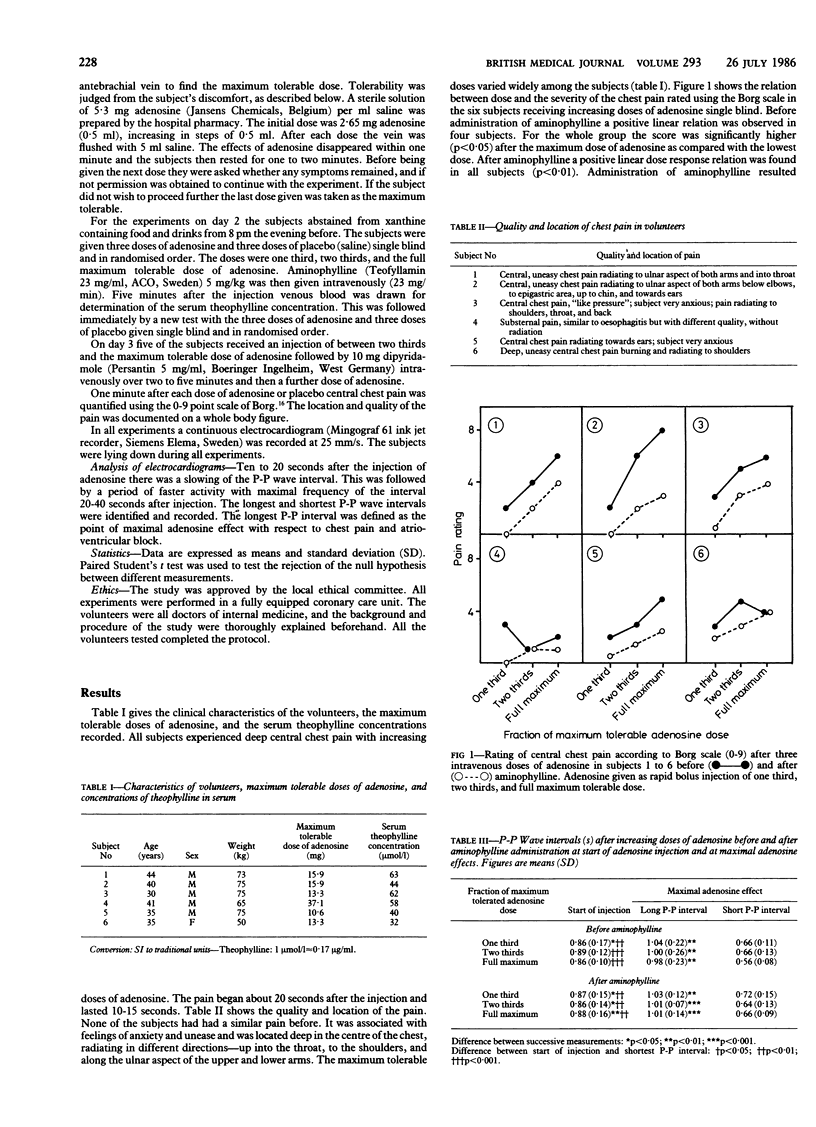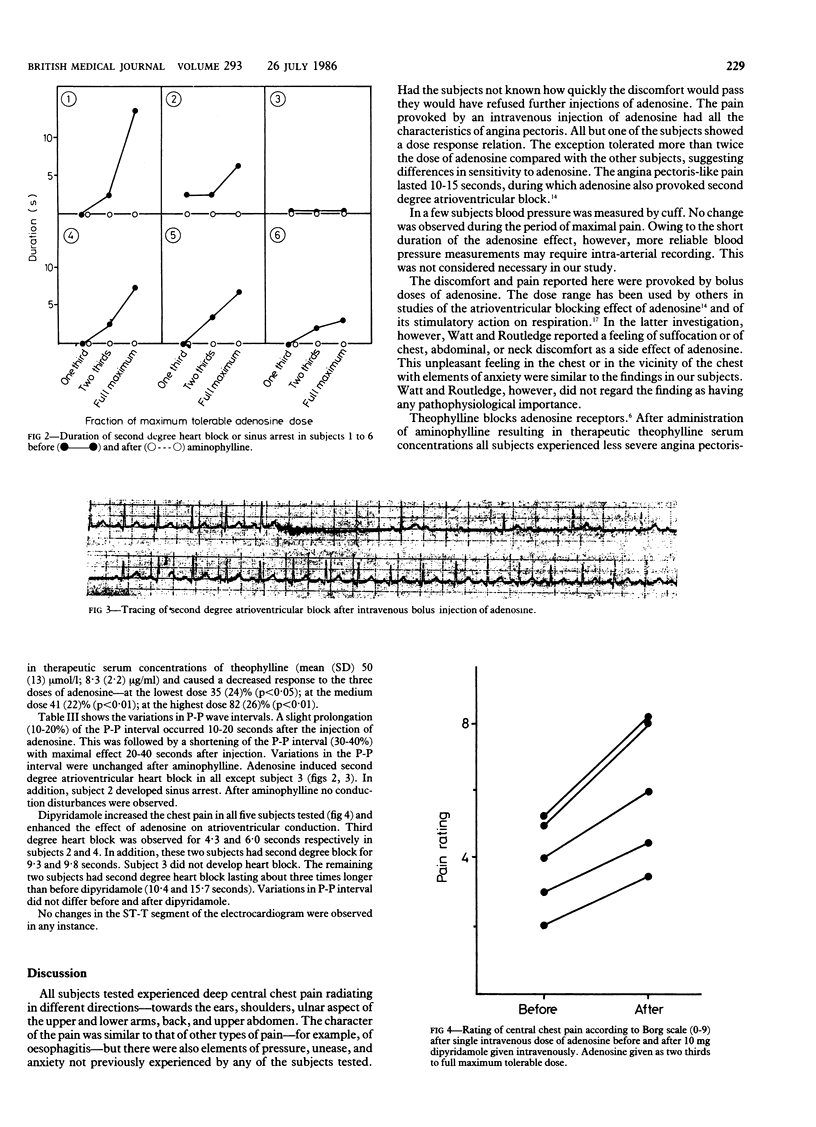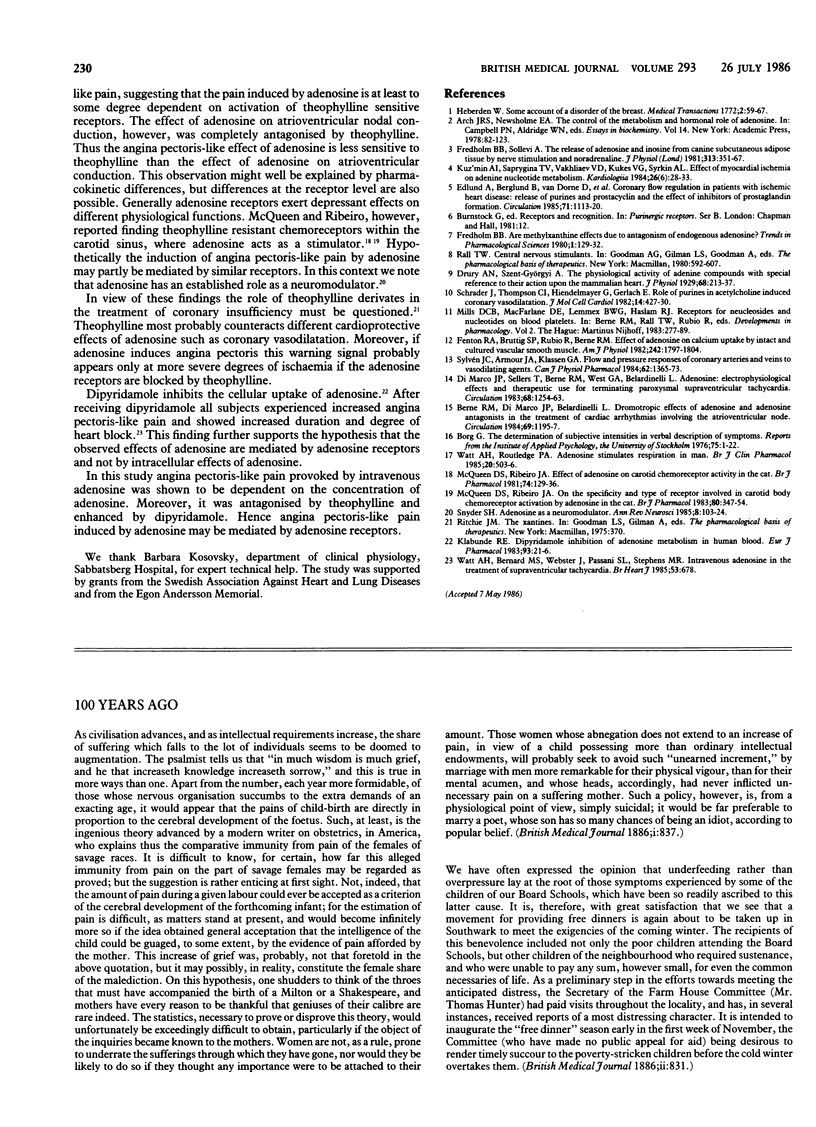Abstract
In a study to characterise the chest pain induced by adenosine this agent was given as a bolus into a peripheral vein to six healthy volunteers (five men) aged 30-44. On the first day the maximum tolerable dose was determined in each case. On the second day three doses of adenosine (one third, two thirds, and the full maximum tolerable dose) and three doses of saline were given single blind in randomised order. Thereafter aminophylline 5 mg/kg was given and the procedure repeated in a different randomised order. On the third day between two thirds and the full maximum tolerable dose was given followed by 10 mg dipyridamole intravenously and a second injection of the same dose of adenosine. Heart rate and atrioventricular blocks were recorded by electrocardiography. One minute after each dose of adenosine the chest pain was scored. The maximum tolerable dose of adenosine ranged from 10.6 to 37.1 mg. All subjects experienced uneasy central chest pain provoking anxiety. The pain radiated to the shoulders, ulnar aspect of the arms, epigastric area, back, and into the throat. The pain began about 20 seconds after the injection and lasted 10-15 seconds. Increasing the dose of adenosine increased the intensity of the pain. Administration of aminophylline reduced the pain significantly. Second degree heart block was recorded in five of the six subjects during the time that the pain was experienced. After aminophylline no block was observed. Dipyridamole increased the intensity of pain. The duration of second degree heart block increased in four of the subjects, and in two of these third degree heart block occurred. These findings suggest that adenosine released from the myocardium during ischaemia induces angina pectoris by stimulating theophylline sensitive receptors.
Full text
PDF



Selected References
These references are in PubMed. This may not be the complete list of references from this article.
- DiMarco J. P., Sellers T. D., Berne R. M., West G. A., Belardinelli L. Adenosine: electrophysiologic effects and therapeutic use for terminating paroxysmal supraventricular tachycardia. Circulation. 1983 Dec;68(6):1254–1263. doi: 10.1161/01.cir.68.6.1254. [DOI] [PubMed] [Google Scholar]
- Drury A. N., Szent-Györgyi A. The physiological activity of adenine compounds with especial reference to their action upon the mammalian heart. J Physiol. 1929 Nov 25;68(3):213–237. doi: 10.1113/jphysiol.1929.sp002608. [DOI] [PMC free article] [PubMed] [Google Scholar]
- Edlund A., Berglund B., van Dorne D., Kaijser L., Nowak J., Patrono C., Sollevi A., Wennmalm A. Coronary flow regulation in patients with ischemic heart disease: release of purines and prostacyclin and the effect of inhibitors of prostaglandin formation. Circulation. 1985 Jun;71(6):1113–1120. doi: 10.1161/01.cir.71.6.1113. [DOI] [PubMed] [Google Scholar]
- Fredholm B. B., Sollevi A. The release of adenosine and inosine from canine subcutaneous adipose tissue by nerve stimulation and noradrenaline. J Physiol. 1981;313:351–367. doi: 10.1113/jphysiol.1981.sp013670. [DOI] [PMC free article] [PubMed] [Google Scholar]
- Klabunde R. E. Dipyridamole inhibition of adenosine metabolism in human blood. Eur J Pharmacol. 1983 Sep 16;93(1-2):21–26. doi: 10.1016/0014-2999(83)90026-2. [DOI] [PubMed] [Google Scholar]
- Kuz'min A. I., Saprygina T. V., Vakhliaev V. D., Kukes V. G., Syrkin A. L. Vliianie ishemii miokarda na obmen adenilovykh nukleotidov. Kardiologiia. 1984 Jun;24(6):28–33. [PubMed] [Google Scholar]
- McQueen D. S., Ribeiro J. A. Effect of adenosine on carotid chemoreceptor activity in the cat. Br J Pharmacol. 1981 Sep;74(1):129–136. doi: 10.1111/j.1476-5381.1981.tb09964.x. [DOI] [PMC free article] [PubMed] [Google Scholar]
- McQueen D. S., Ribeiro J. A. On the specificity and type of receptor involved in carotid body chemoreceptor activation by adenosine in the cat. Br J Pharmacol. 1983 Oct;80(2):347–354. doi: 10.1111/j.1476-5381.1983.tb10040.x. [DOI] [PMC free article] [PubMed] [Google Scholar]
- Schrader J., Thompson C. I., Hiendlmayer G., Gerlach E. Role of purines in acetylcholine-induced coronary vasodilation. J Mol Cell Cardiol. 1982 Jul;14(7):427–430. doi: 10.1016/0022-2828(82)90174-2. [DOI] [PubMed] [Google Scholar]
- Sylven J. C., Armour J. A., Klassen G. A. Flow and pressure responses of coronary arteries and veins to vasodilating agents. Can J Physiol Pharmacol. 1984 Nov;62(11):1365–1373. doi: 10.1139/y84-228. [DOI] [PubMed] [Google Scholar]
- Watt A. H., Routledge P. A. Adenosine stimulates respiration in man. Br J Clin Pharmacol. 1985 Nov;20(5):503–506. doi: 10.1111/j.1365-2125.1985.tb05108.x. [DOI] [PMC free article] [PubMed] [Google Scholar]


